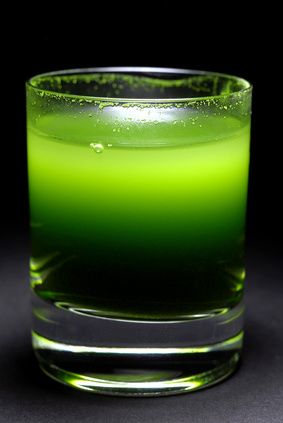Wheatgrass is the young grass of the wheat plant, Triticum aestivum. Chlorophyll, which makes up over 70% of the solid content of wheatgrass juiceis the basis of all plant life. Wheatgrass juice is often called the “Liquid Sunshine” because of its very high content of chlorophyll. Wheatgrass is available as a powder, fresh produce, in tablet form and as a juice concentrate.
Wheatgrass Powder Benefits
Wheatgrass juice contains 70% crude chlorophyll. The chlorophyll molecule is very similar in structure to the haemoglobin molecule, the oxygen carrier in our blood. Wheatgrass juice is an excellent blood tonic, increasing the haemoglobin content of the blood and improving oxygen transport, it is thus helpful with people suffering anaemia. According to the Hippocrates Health Institute, wheatgrass increases red blood-cell count and lowers blood pressure. The red cell count has returned to normal within 4 to 5 days of the administration of chlorophyll, even in those animals that were known to be extremely anemic or low in red blood cell count.
 Studies of wheatgrasss juice indicate it may help reduce symptoms of distal ulcerative colitis, reduce the need for transfusions in patients with thalassemia major and may decrease myelotoxicity in breast cancer patients undergoing chemotherapy. A small clinical trial involving twenty-one patients with distal ulcerative colitis showed that wheatgrass can reduce the symptoms associated with the disease. The Scandavian Journal of Gastroenterology in 2002 published a study showing that wheatgrass can help alleviate symptoms of ulcerative colitis. One study was done on children with Thalassemia, a genetic form of anemia, who require regular blood transfusions. After taking 100 ml of wheatgrass juice daily for a year, half of the patients only needed 75% of the amount of blood they used to get in order to stay well. A 2007 study published in Nutrition and Cancer found that patients undergoing chemotherapy for breast cancer had lower myelotoxicity and reduced need for medications to stimulate white blood cell production.
Studies of wheatgrasss juice indicate it may help reduce symptoms of distal ulcerative colitis, reduce the need for transfusions in patients with thalassemia major and may decrease myelotoxicity in breast cancer patients undergoing chemotherapy. A small clinical trial involving twenty-one patients with distal ulcerative colitis showed that wheatgrass can reduce the symptoms associated with the disease. The Scandavian Journal of Gastroenterology in 2002 published a study showing that wheatgrass can help alleviate symptoms of ulcerative colitis. One study was done on children with Thalassemia, a genetic form of anemia, who require regular blood transfusions. After taking 100 ml of wheatgrass juice daily for a year, half of the patients only needed 75% of the amount of blood they used to get in order to stay well. A 2007 study published in Nutrition and Cancer found that patients undergoing chemotherapy for breast cancer had lower myelotoxicity and reduced need for medications to stimulate white blood cell production.
Science has proven that chlorophyll arrests growth and development of unfriendly bacteria. In the American Journal of Surgery , Benjamin Gruskin, MD recommends chlorophyll for its antiseptic benefits. Though it does not destroy bacteria directly, wheatgrass consumption creates an unfavorable environment for germs, according to The Wheatgrass Juicer. Wheatgrass creates an alkaline environment which is not in favor of bacterial growth and yeast.
Wheatgrass is a natural source of vitamins and minerals. Wheatgrass is a great source of beta carotene, contains most of the B vitamins and vitamins C, E and K and also contains over 90 different minerals and 19 amino acids. Wheat grass also contains superoxide dismutase, a substance used by the body as part of its natural antioxidant defense system. Researchers have confirmed that this enzyme can lessen cellular decay or aging and prevent cellular damage caused by stress, heart attacks and pollutants.
One of wheatgrass benefits is that it has shown to improve liver functioning. Chlorophyll oxygenates the blood and organ tissue, impedes the growth of harmful bacteria in the digestive tract, neutralizes toxins and helps purify the liver. Dr. Wescott reported that when chlorophyll is taken internally in adequate quantities, it reduces or eliminates offensive body and breath odors.
Wheatgrass Juice is a superior detoxification agent compared to carrot juice and other fruits and vegetables. Wheatgrass cleanses, purifies and feeds the body by activating the white blood cells, which boost the body’s immune system.
Recent studies show that wheatgrass juice has a powerful ability to fight tumors without the usual toxicity of drugs that also inhibit cell-destroying agents. Wheatgrass juice contains natural enzymes, which help the bodies defence mechanism by strengthening cells and removing poisons from the blood stream.
Wheatgrass juice protects the lungs and blood from water and air pollution, toxins, cigarette smoke and heavy metals. The many detergent factors of wheatgrass juice will drain the lymph system, which carries away many toxins from body cells. Chlorophyll will bring toxins stored away in cells or fatty tissues into the bloodstream.
How to Use Wheatgrass?
Wheatgrass can be served juiced or made into a powder. Dosage: 1 to 4 oz daily. Therapeutic dosage 4 to 8 oz daily. For transfusion dependent beta thalassemia or ulcerative colitis, 100 milliliters of wheatgrass juice daily has been found effective. The suggested serving of powder is 1 to 3 tbsp. Tablet dosage for adults; 5-15 tablets daily (500mg). Wheatgrass juice does not combine well with other foods and should always be taken on an empty stomach.
Wheatgrass Side Effects and Dangers
People who are allergic to wheat should not take wheatgrass as a supplement. Many reported wheatgrass side effects have been linked to contamination of soil constituents.
Leave a Reply